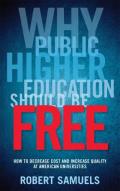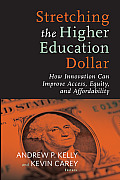- About
- Programs
- Issues
- Academic Freedom
- Political Attacks on Higher Education
- Resources on Collective Bargaining
- Shared Governance
- Campus Protests
- Faculty Compensation
- Racial Justice
- Diversity in Higher Ed
- Financial Crisis
- Privatization and OPMs
- Contingent Faculty Positions
- Tenure
- Workplace Issues
- Gender and Sexuality in Higher Ed
- Targeted Harassment
- Intellectual Property & Copyright
- Civility
- The Family and Medical Leave Act
- Pregnancy in the Academy
- Publications
- Data
- News
- Membership
- Chapters
From Bureaucratic Entropy to Student-Centered Institutions
Why Public Higher Education Should Be Free: How to Decrease Cost and Increase Quality at American Universities. Robert Samuels. New Brunswick, NJ: Rutgers University Press, 2013.
Stretching the Higher Education Dollar: How Innovation Can Improve Access, Equity, and Affordability. Andrew P. Kelly and Kevin Carey, eds. Cambridge, MA: Harvard Education Press, 2013.
Higher education has been the focus of considerable concern, and often consternation, in recent years. Many commentators, both in and outside academia, are disturbed by the emergence of the “corporate university” and the rising cost of tuition resulting from the rapid expansion of the administrative sector at the expense of instructional resources and faculty salaries. Critics have also attacked the growing emphasis on undergraduate education as a pathway to financial success, which is seen as undercutting a more holistic liberal arts education. Crowded classrooms, falling retention rates, increasing time to obtain a degree, skyrocketing student debt, and the reduction of financial aid to the poorest students, who desperately need this support, are also extremely troubling.
Why Public Higher Education Should Be Free, by Robert Samuels, and Stretching the Higher Education Dollar, edited by Andrew P. Kelly and Kevin Carey, address the current challenges in higher education from often-opposing perspectives. Samuels, a lecturer at the University of California, Los Angeles, and president of a union representing more than three thousand lecturers and librarians in the University of California system, primarily addresses conditions at major public research universities with selective admissions. He is particularly interested in the costs imposed by these institutions’ emphasis on research and graduate education. In contrast, Carey, director of the education policy program at the New America Foundation, and Kelly, a resident scholar at the conservative American Enterprise Institute, focus in their collection on conditions at all US institutions of higher education, including many that are not selective.
Despite their different emphases, however, the two books have a surprising convergence in their conclusions and recommendations. Both argue that colleges and universities have bloated budgets that reward an ever-increasing number of administrators and that allocate scarce resources to nonacademic programs, like sports, and to the construction and maintenance of grandiose nonacademic buildings. Institutional resources should be used more wisely to improve education, these books argue, especially for undergraduates. By shortchanging undergraduate education. and leaving many students with a crushing debt burden, the escalating cost of higher education has created an unsustainable situation. \
Samuels, Carey, and Kelly agree that institutions of higher education must drastically change their priorities to focus on student learning and development. At the same time, they argue that these institutions need to cut nonessential costs by increasing the efficiency of administration and reducing the structural tendency to spend substantial amounts of money on facilities and programs that do not contribute to the core academic mission.
The authors diverge on the issue of technology, which Samuels largely dismisses as a potential source of innovation in higher education. By contrast, Stretching the Higher Education Dollar, which is subtitled How Innovation Can Improve Access, Equity, and Affordability, includes essays by entrepreneurs such as Ari Blum and Dave Jarrat of InsideTrac, Burck Smith of StraighterLine, and Michael Staton of Uversity (formerly Inigral), who are trying to market new technology-enabled student coaching and tutoring services and private social networks to higher education institutions. Despite this emphasis on technology, the contributors to Stretching the Higher Education Dollar agree with Samuels that there is a compelling case for making institutions of higher education student-centered as well as for reforming incentives that currently lead to wasteful administrative practices. The authors emphatically agree that these changes must occur before institutions make major investments in new technology.
In his essay in Stretching the Higher Education Dollar, “Incentives, Information and the Public Interest,” Robert E. Martin uses historical data on the evolution of higher education costs from the Delta Project (which is also heavily cited by several other authors in the collection as well as by Samuels) to test hypotheses about what drives cost increases. Martin concludes that increases are primarily driven not by “Baumol’s cost disease”—the inability to improve instructional productivity—but by shrinking administrative productivity and competition between institutions to build monuments to administrator and donor egos, such as expensive student centers, gyms, and football stadiums. These nonacademic costs divert crucial resources from the core mission of educating students. This conclusion is reinforced by Jeffrey J. Selingo’s essay, “Bain Goes to College,” which demonstrates how several studies by the consulting firm Bain and Company have found administrative inefficiencies caused by self-indulgent management practices that, if corrected, would result in massive cost savings.
In Stretching the Higher Education Dollar, the essays “Applying Cost Effectiveness Analysis to Higher Education,” by Douglas N. Harris; “A Strategic Approach to Student Services,” by Ari Blum and Dave Jarrat; and “Unbundling Higher Education,” by Michael Staton, all reach conclusions that are related and mutually reinforcing: higher education institutions must provide each undergraduate with personalized support, evaluation, and feedback to help with the transition to college life as well as to enable the student to achieve a mastery of new knowledge and skills, whether the student wishes to become a doctor or a poet. These essays conclude that once an institution has adjusted its priorities to focus on student learning, it can benefit from new technology and other services to save effort and money.
For example, if online course materials such as lectures, quizzes, readings, and simulated experiments are used primarily to reduce instructional costs, with no corresponding shift in institutional priorities, they are likely to harm students and reduce the value of the institution’s brand. But if they are used for increased individual coaching and mentoring, performance feedback, and more intensive personalization of each student’s educational pathway, these materials can greatly benefit students and improve an institution’s brand. Similarly, online provision of specialized student services, such as financial aid counseling, can be harmful if adopted primarily to reduce costs. But if such technology increases the quality of service by delivering greater expertise drawn from a broader base than any individual institution can provide, it could improve graduation rates and allow greater focus on core academic goals.
In addition to providing higher education that is truly student-centered through revised budgetary priorities, the important message of both Why Public Higher Education Should Be Free and Stretching the Higher Education Dollar is that the solutions to current problems of higher education cannot be achieved through greater use of technology in the classroom until institutional priorities change. It is imperative that our educational institutions focus on the development of each student as an individual, not as a profit center. Without the right priorities, technology and innovation cannot save the day.
Wendy Martin is professor of American literature and American studies at Claremont Graduate University, where she has also served as chair of the English department and as vice provost and founding director of the transdisciplinary studies program. Jed Harris is president of Mindloom, an Internet services company; he was previously a distinguished engineer at Apple and director of the artificial intelligence lab at Intel.





